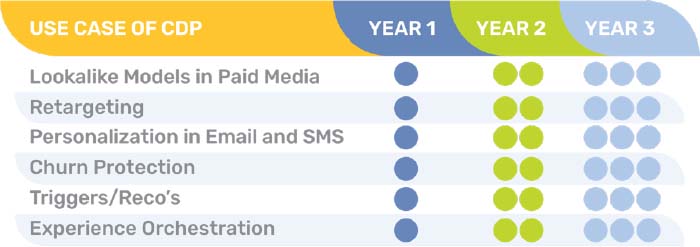Are Customer Data Platforms (CDPs) worth the investment? What are the business outcomes CDPs deliver? What is the Return on Investment (ROI)? These are the questions Marketing leaders must ask to prove the value of a CDP as an investment, just like a new product, new store, new capital equipment. And to do that, we need a business case. Like all business cases, our CDP business case should:
- Plan for the tangible, measurable, business benefits a CDP will deliver
- Demonstrate incremental value (that wouldn’t be there without the CDP)
- Deliver long-term profit while delivering a short-term payback
- Align with business strategies and integrate into the existing MarTech stack
For today’s Marketers, the adoption of a CDP reflects an environment where real-time data capture, AI, and a unified customer view are not just advantages but necessities. And yet, in some organizations, the concept of “marketing ROI” is still treated like an abstract concept rather than a tangible metric tied to customer data that fuels every marketing decision. This can raise questions from the CFO and other members of the C-suite, who work hard to ensure the company’s resources are being directed to the initiatives with the highest impact.
Customer Data Platforms must deliver incremental value
At its core, a CDP is an integrated customer database that consolidates and manages customer data from various sources. It’s designed to provide a comprehensive, unified profile for each customer. CDPs ingest and unify data from multiple touch points, like social media interactions, transaction histories, website browsing and even customer service experiences. In turn, CDPs then enable marketers to deliver highly personalized experiences in real-time while a customer is interacting with a brand.
CDPs enable teams to engage customers more effectively, orchestrate customer journeys, and optimize Marketing Communications (MarCom) by leveraging real-time insights and predictive analytics. That’s a big promise; a fundamental shift towards truly customer-centric marketing.
Start with top CDP “use cases”
Marketing leaders have to be clear on how they will deliver incremental value from a CDP investment. Marketing leaders borrow the term “use case” to demonstrate scenarios that demonstrate a measurable impact on business.
What are the use cases for CDPs? There are hundreds to choose from. A good starting point comes from the CDP Institute. From my experience, there are six marketing scenarios to create measurable impact and incremental value:
- Lookalike Models in Paid Media: A CDP can enhance the effectiveness of paid media, which is the foundation of new customer acquisition. My advice is to go beyond demographic lookalikes. The best CDPs can get closer to attitudes and motivations that inspire customers. Ask for in-market signals, search-alikes, browse-alikes which are effective models for audience development.
- Retargeting: A CDP can enlarge audiences for retargeting and help create personalized follow-ups from the brand, across channels. This is some of the most effective MarCom for a brand, the question being – how can a CDP improve upon retargeting?
- Personalization in Email and SMS: A CDP can help tailor messaging in email and SMS marketing to optimize for cadence, offers, images. This is a perfect application of Artificial Intelligence where individual customers might get a unique message. Email and SMS campaigns are easy to measure and optimize with a/b tests, so start there. Send time optimization and selecting the right communication channel should be easy for a CDP.
- Churn Protection: A CDP can predict churn and help protect against losing valuable customers through inactivity. First, make sure you have a unified customer view (and don’t say “we miss you” if a customer is buying under a different profile). Next, use predictive analytics to not only anticipate churn, but test different win-back tactics.
- Triggers/Recommendations: A CDP can pinpoint the optimal moment in the customer lifecycle for cross-sell and upsell opportunities. This usually starts with predictions as well, such as “next product” but a CDP can enlarge that thought to “next message” (e.g., back in stock, you’re close to a loyalty threshold, etc.).
- Experience Orchestration: Research shows that customers get annoyed quickly if a brand fails to create a seamless and consistent brand interaction. Customers expect brands to recognize them and deliver omnichannel experiences (blurring the lines between digital and in-store). Customers see brands, not channels.
When used effectively, a CDP can have an incredible impact on the way you interact with your customers and how your brand is perceived in the marketplace. CPDs can deliver a measurable boost to your bottom line with incremental value that goes beyond the fundamental use cases.
What are your use cases? Where are your gaps? Which gaps do you want to close in what priority? While your use cases will be different, the process is the same.
The strategic value of a CDP
Marketing leaders estimate the positive benefit of closing the gap against the level of effort (LOE). Marketing leaders can plot these on a roadmap – quick win versus long-term benefit. Not only can CDPs close gaps, but they quickly deliver business value that has short and long-term ROI. CDPs are about business outcomes more than MarCom and technology. And it leads to important questions such as do you have the internal capability, bandwidth and expertise to deliver? Our agencyspecializes in CDP readiness, CDP implementation and CDP operations to deliver long-term benefit. Show how the CDP can deliver incrementality over the long term. Here are the same six use cases, plotted in terms of margin delivered over 3 years:

To calculate incrementality consider:
- Size of customer base or audience affected
- Marketing’s impact or ability to get customers to change behavior (buy more, attach another product, spend more, buy without a price incentive, try new departments, add on services, buy more often, etc.)
- Investment levels (e.g., campaigns/month) and size of budget
Don’t guess at this. These estimates can come from:
- Tests for incrementality – a/b testing, pilot programs, proof of concepts (POCs), experiments against holdout groups. Ask your CDP vendor if they are willing to assist with POCs and testing.
- Benchmarks – if you don’t have empirical data, use industry averages from secondary research. Better yet, analyze prior results and take an educated guess at future performance.
My advice: be honest, show your assumptions then be open to adjusting as you go.
Bring it all together by building a CDP business case
A strong business case positions your CDP as a critical investment when you are looking to optimize marketing efforts and drive long-term profitability. Your CDP business case should answer questions such as: How much does it cost to build a CDP? How will you make back the CDP investment? What is the ratio between the two – the Return on Marketing Investment (RoMI)?

How will finance react to your CDP business case?
When Marketing leaders work closely with Finance, good things happen. But it’s up to Marketing leaders to take the first step: Define success, show the incremental benefit you expect, and be accountable. My advice is to use Finance’s templates and replicate their methodologies. You can determine the KPIs together, which will lead to (1) consensus, and (2) a sense of ownership on both sides. What do you think Finance leaders are thinking while you present your CDP business case:
- Is your business case realistic and achievable (what are the assumptions? what are our internal capabilities)?
- Did you account for all the costs?
- Is your projected RoMI better than other alternatives I’m considering?
- What is the payback period?
- Will you (Marketing) be accountable?
- What are the risks?
Beyond the business case, plan on ongoing accountability. This means tracking (via executive dashboards), communication and continuous adjustment as you optimize in the market results. It boils down to trust. Does Finance trust your projections? Where do they come from? What is your track record? Have you done a pilot program? Likelihood survey? Trust but verify.
Marketing leaders also have strategic goals (e.g., defend against competitors, enter a new market, gain new customers, retain existing customers), but when presenting to Finance, stick to the tangible RoMI. Use their templates; use their formulas (e.g., setup costs are Capital Expenditures or CapEx; ongoing costs are Operational Expenditures or OpEx).
Marketers should be familiar with the concept of Net Present Value (NPV) or the discount applied to revenue received in the future, which is less valuable than cash in hand. This shows Finance your projections are conservative. In other words, you didn’t underestimate the costs.
A CDP Marketing Agency can help maximize your ROI
The potential of CDPs is fully realized when paired with the expertise of a specialized CDP Marketing Agency. Such an agency, particularly one with a deep understanding of digital marketing, can be the catalyst that ensures your CDP not only fits seamlessly within your marketing operations but also drives incremental value.
A proficient CDP Marketing Agency can help you navigate the complexities of CDP implementation, from data integration to experience orchestration, ensuring that every feature is tuned to resonate with your unique business needs and customer expectations. Their experience can translate into accelerated CDP adoption, more personalized customer journeys, and ultimately, a stronger bottom line.
Today, data is abundant, getting the most out if it is challenging. Partnering with a CDP Marketing Agency is not just about optimizing your CDP; it’s about transforming your marketing efforts with personalized engagement and revenue generation.
Download our Business Case Template to get you started. And after that, book a call with one of our experts to learn how to extract the most value out of your CDP.
Topics: customer data cdp ROI business case businesscase cdpagency
Photo by Conny Schneider on Unsplash












